Modelling and Prediction of Cutting Temperature in the Machining of H13 Hard Steel of Transient Heat Conduction
Abstract
:1. Introduction
2. Modeling of Heat Conduction in Coated Tools
- (1)
- Machining is performed at ambient temperature assuming that the initial temperature of both the workpiece and the tool is equal to the room temperature (T0 = 20 °C).
- (2)
- The heat flux into the coated tools will pass through the thin coating layer and the substrate of the tools and will not be lost through other ways. There is not any heat conduction with the environment.
- (1)
- Thermal properties such as conductivity and diffusivity are independent of temperature, and they are uniform for a coating layer.
- (2)
- The substrate body of the cutting tool is a semi-infinite body along the coating thickness direction as shown in Figure 2.
3. Experimental Setup
4. Results and Discussion
4.1. Experimental Verification
4.2. Effects of Cutting Time on Temperature Distribution
4.3. Temperature Distribution with Fourier and Non-Fourier Heat Conduction
5. Conclusions
- The effects of cutting time on TiN-coated tools’ temperature distribution were investigated. When cutting time was short enough, the temperatures have a fluctuating change process, and the fluctuating change gradually disappears with the decreases with the weakening of the transient degree. With the increase of cutting time, the heat conduction changed from transient-state to steady-state, the cutting temperature increased, and stabilized gradually. When the cutting time is constant, the farthest away from the coating surface, the lower the temperature in the tool body.
- It is found that the non-Fourier heat conduction effect exists in the cutting heat transient conduction of coated tool machining. When the heat conduction is transient heat conduction, the thermal disturbance and thermal delay caused by thermal shock can be accurately described by the non-Fourier heat conduction model.
- The temperature predicted error with the transient heat conduction model is less than 12%. The transient heat conduction model was a suitable application to intensity transient-state and transient-state.
Author Contributions
Funding
Institutional Review Board Statement
Informed Consent Statement
Data Availability Statement
Conflicts of Interest
References
- Kalss, W.; Reiter, A.; Derflinger, V.; Gey, C.; Endrino, J.L. Modern coatings in high performance cutting applications. Int. J. Refract. Met. Hard Mater. 2006, 24, 399–404. [Google Scholar] [CrossRef]
- Klocke, F.; Krieg, T.; Gerschwiler, K.; Fritsch, R.; Zinkann, V.; Pöhls, M.; Eisenblätter, G. Improved cutting processes with adapted coating systems. CIRP Ann. 1998, 47, 65–68. [Google Scholar] [CrossRef]
- Sandvik, C. Modern Metal Cutting: A Practical Handbook; Sandvik Coromant: Sandviken, Sweden, 1994. [Google Scholar]
- Yan, S.; Zhu, D.; Zhuang, K.; Zhang, X.; Ding, H. Modeling and analysis of coated tool temperature variation in dry milling of Inconel 718 turbine blade considering flank wear effect. J. Mater. Process. Technol. 2014, 214, 2985–3001. [Google Scholar] [CrossRef]
- Baïri, A.; Laraqi, N. Effect of thickness and physical properties of films on the thermal behavior of a moving rough interface. Eur. Phys. J. Appl. Phys. 2004, 26, 29–34. [Google Scholar] [CrossRef]
- Benabid, F.; Benmoussa, H.; Arrouf, M. A thermal modeling to predict and control the cutting temperature. The simulation of face-milling process. Glob. J. Res. Eng. 2014, 74, 37–42. [Google Scholar] [CrossRef] [Green Version]
- da Silva, M.B.; Wallbank, J. Cutting temperature: Prediction and measurement methods—A review. J. Mater. Process. Technol. 1999, 88, 195–202. [Google Scholar] [CrossRef]
- Grzesik, W.; Bartoszuk, M.; Nieslony, P. Finite element modelling of temperature distribution in the cutting zone in turning processes with differently coated tools. J. Mater. Process. Technol. 2005, 164, 1204–1211. [Google Scholar] [CrossRef]
- Mozafarifard, M.; Toghraie, D.; Sobhani, H. Numerical study of fast transient non-diffusive heat conduction in a porous medium composed of solid-glass spheres and air using fractional Cattaneo subdiffusion model. Int. Commun. Heat Mass Transf. 2021, 122, 105192. [Google Scholar] [CrossRef]
- Zehnder, A.T.; Rosakis, A.J. On the temperature distribution at the vicinity of dynamically propagating cracks in 4340 steel. J. Mech. Phys. Solids 1991, 39, 385–415. [Google Scholar] [CrossRef]
- Cattaneo, C. A form of heat-conduction equations which eliminates the paradox of instantaneous propagation. Comptes Rendus 1958, 247, 431–433. [Google Scholar]
- Vernotte, P. Les paradoxes de la theorie continue de I’equation de la chleur. Comptes Rendus 1958, 246, 3154–3155. [Google Scholar]
- Kiwan, S.; Al-Nimr, M.; Al-Sharo’a, M. Trial solution methods to solve the hyperbolic heat conduction equation. Int. Commun. Heat Mass Transf. 2000, 27, 865–876. [Google Scholar] [CrossRef]
- Barletta, A.; Zanchini, E. Three-dimensional propagation of hyperbolic thermal waves in a solid bar with rectangular cross-section. Int. Commun. Heat Mass Transf. 1999, 42, 219–229. [Google Scholar] [CrossRef]
- Schwarzwlder, M.C.; Myers, T.G.; Hennessy, M.G. The one-dimensional Stefan problem with non-Fourier heat conduction. Int. J. Therm. Sci. 2020, 150, 106210–106211. [Google Scholar] [CrossRef] [Green Version]
- Ferreira, D.C.; dos Santos Magalhães, E.; Brito, R.F.; Silva, S.M.M. Numerical analysis of the influence of coatings on a cutting tool using COMSOL. Int. J. Adv. Manuf. Technol. 2018, 97, 1305–1314. [Google Scholar] [CrossRef]
- Zhang, J.J.; Liu, Z.G. Transient and steady-state temperature distribution in monolayer-coated carbide cutting tool. Int. J. Adv. Manuf. Tech. 2017, 91, 59–67. [Google Scholar] [CrossRef]
- Dogu, Y.; Aslan, E.; Camuscu, N. A numerical model to determine temperature distribution in orthogonal metal cutting. J. Mater. Process. Tech. 2006, 171, 1–9. [Google Scholar] [CrossRef]
- Ma, L.W.; Cairney, J.M.; Hoffman, M.J.; Munroe, P.R. Effect of coating thickness on the deformation mechanisms in PVD TiN-coated steel. Surf. Coat. Technol. 2010, 204, 1764–1773. [Google Scholar] [CrossRef]
- Grzesik, W.; Nieslony, P.; Grzesik, W. A computational approach to evaluate temperature and heat partition in machining with multilayer coated tools. Int. J. Mach. Tools Manuf. 2003, 43, 1311–1317. [Google Scholar] [CrossRef]
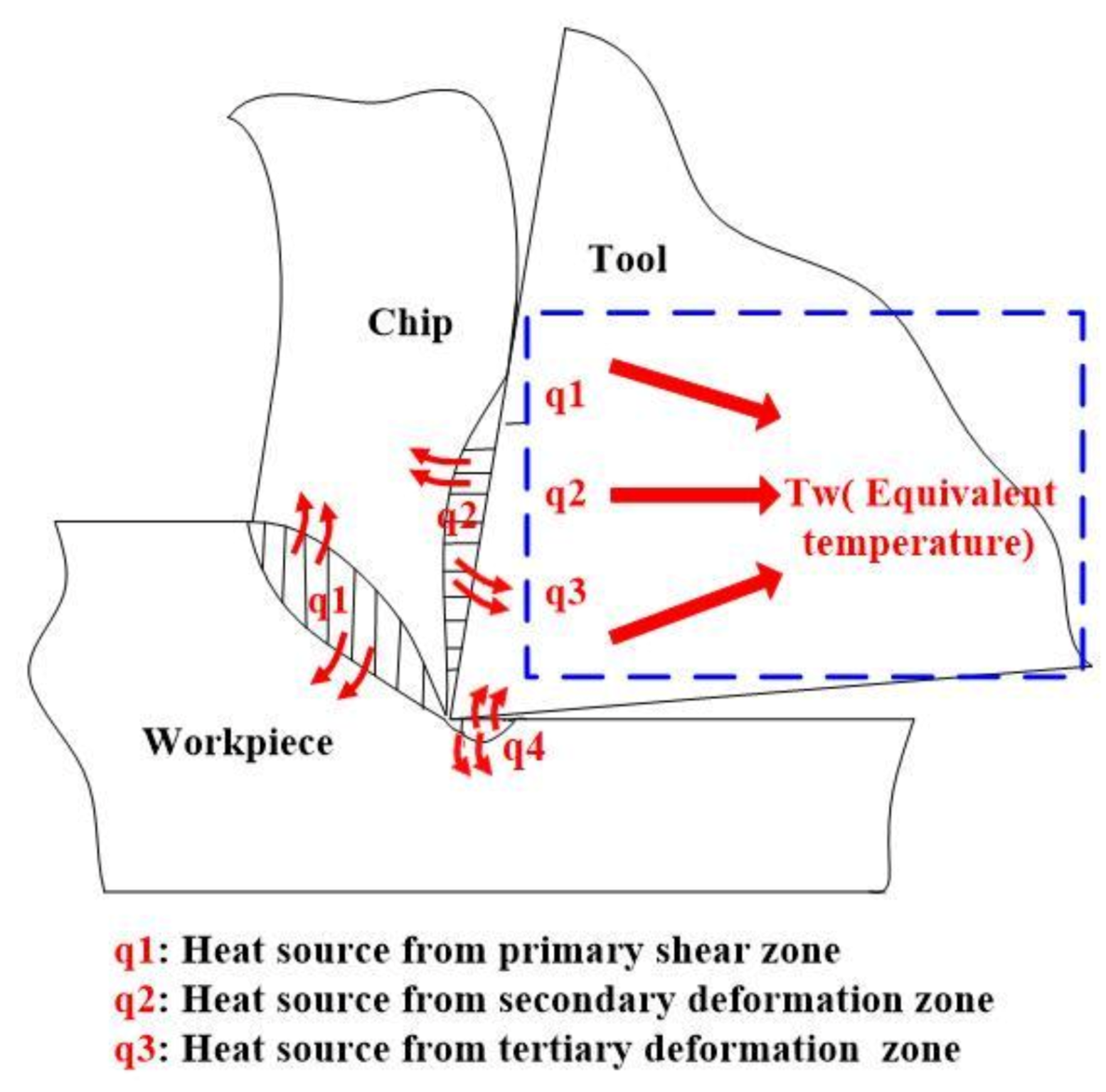

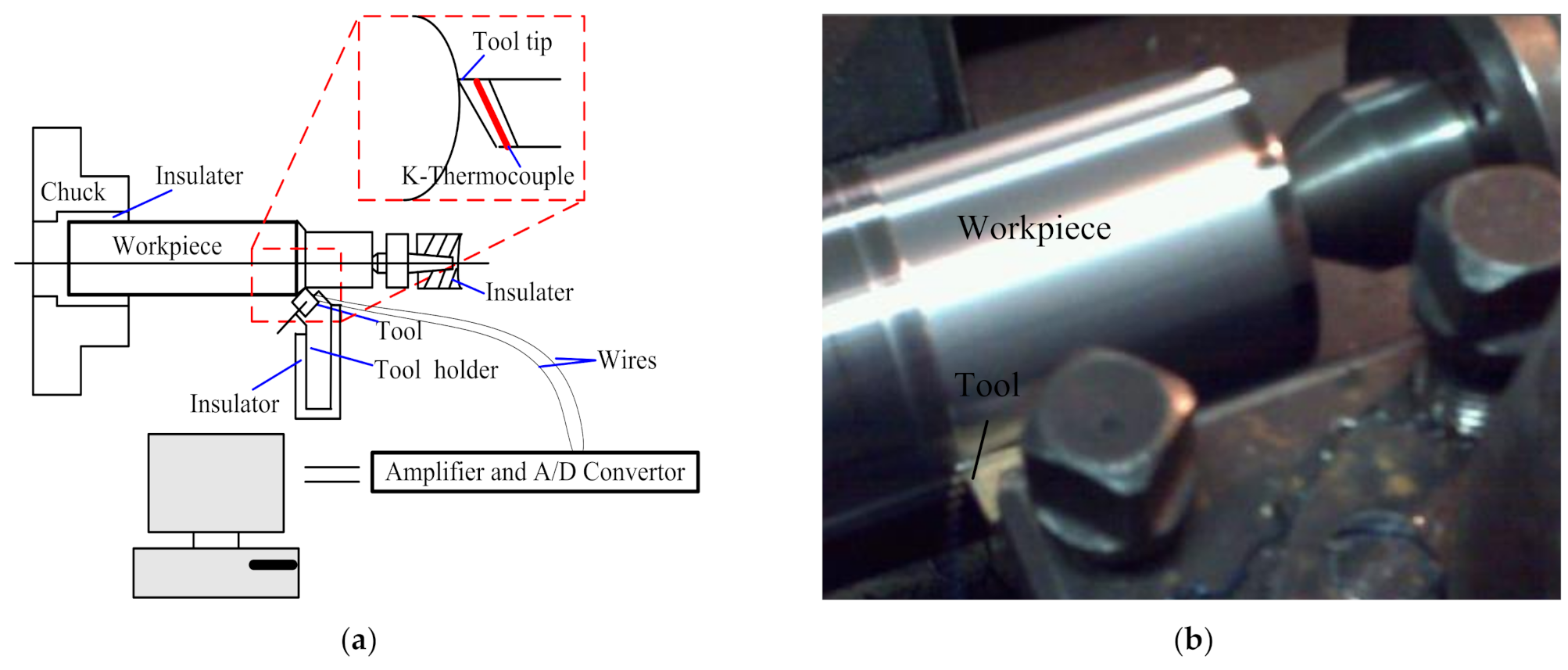
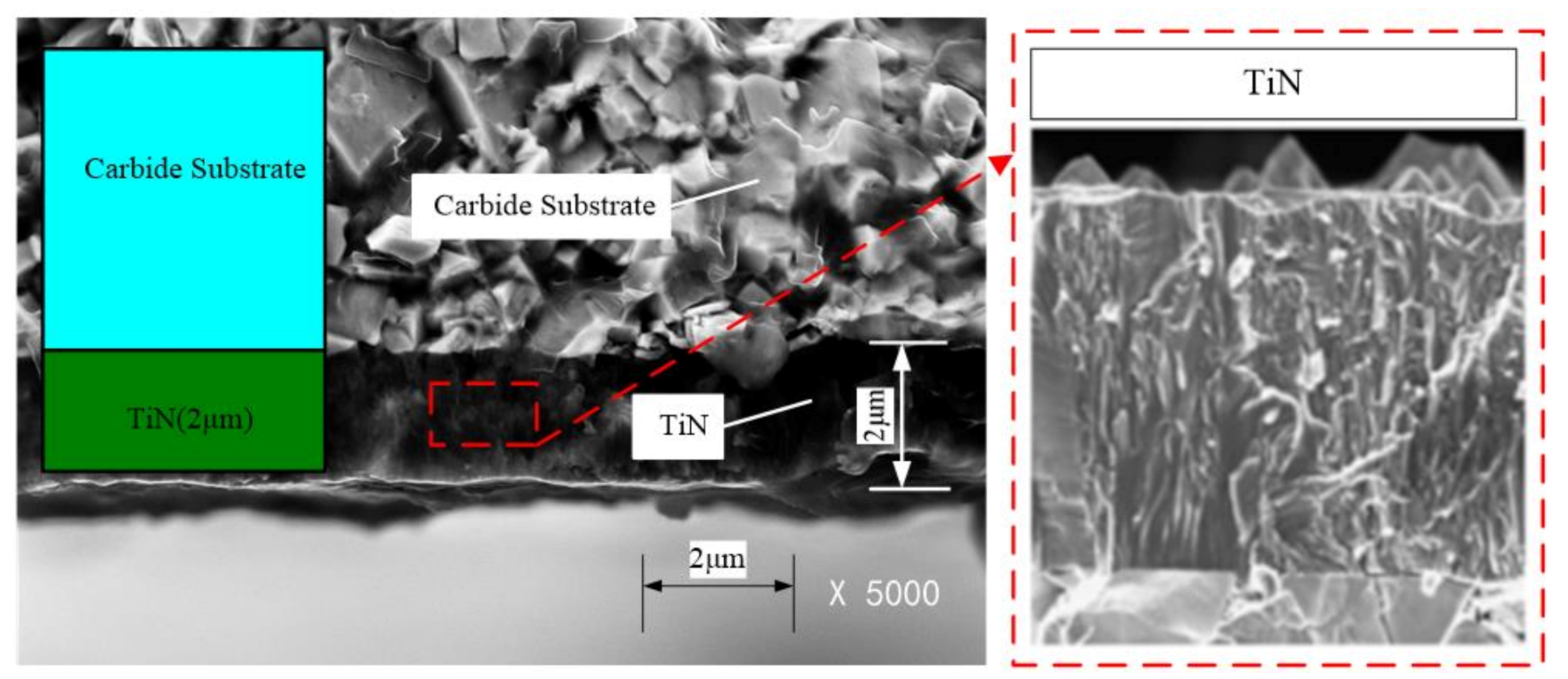


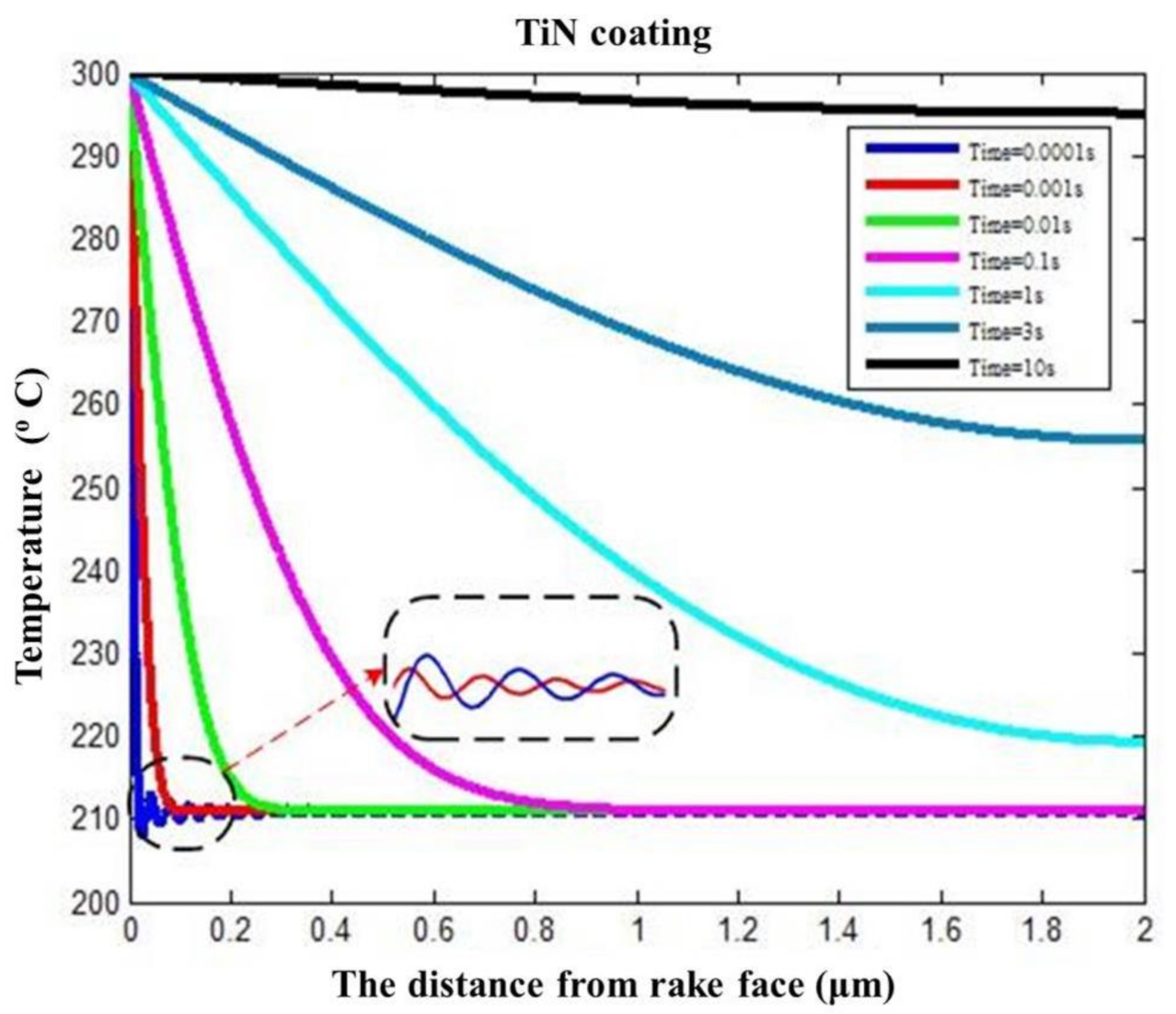
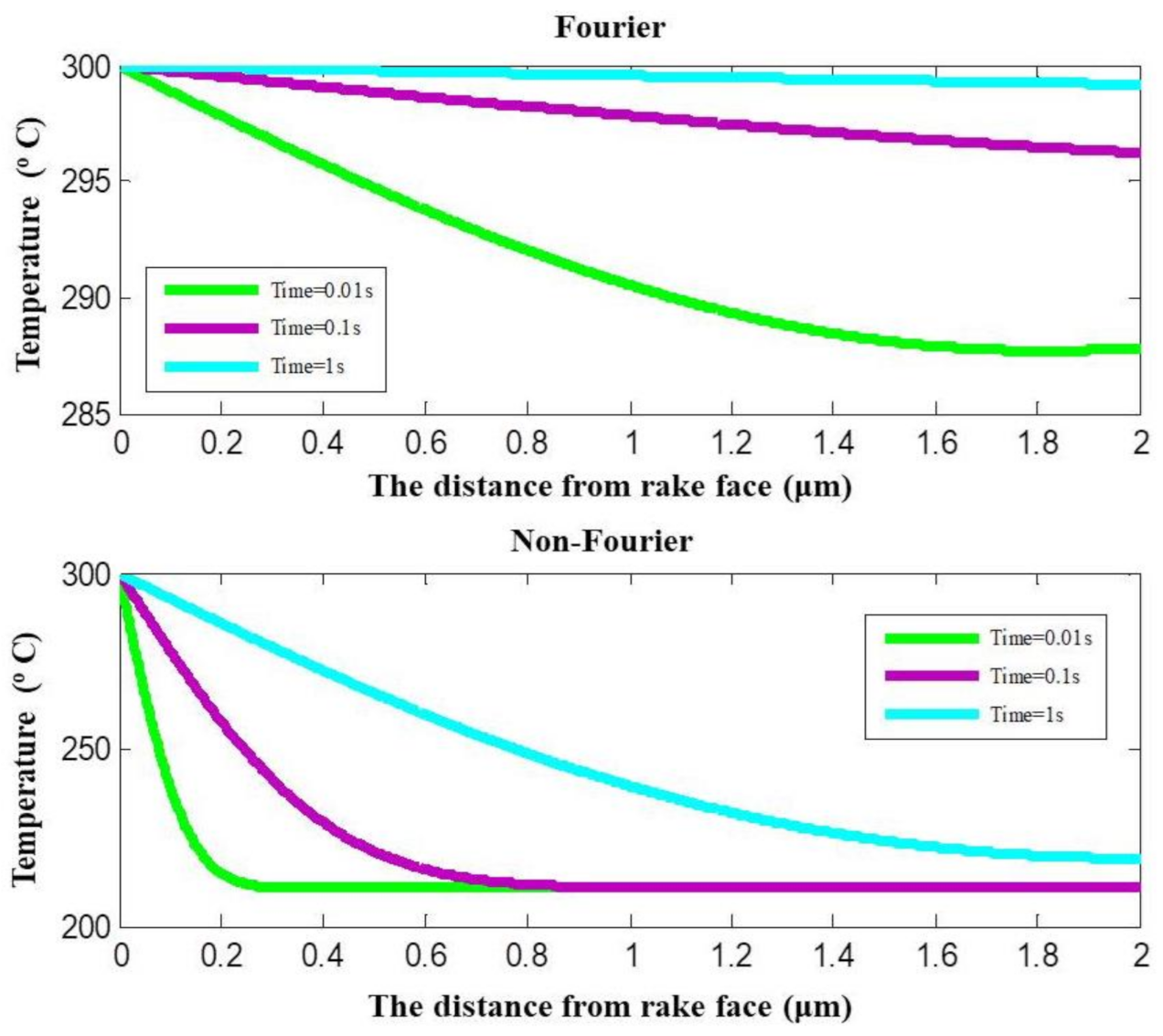
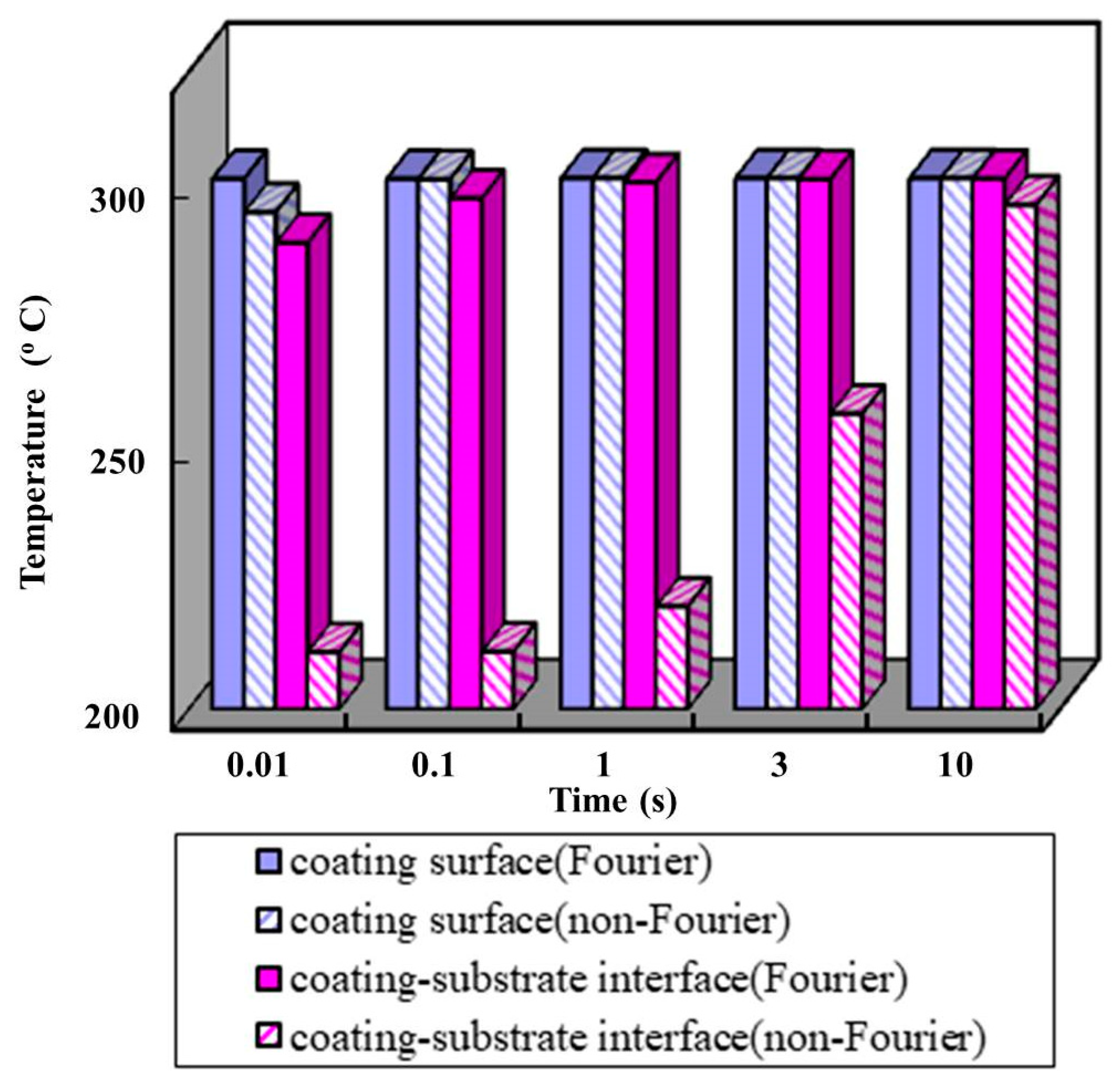
Publisher’s Note: MDPI stays neutral with regard to jurisdictional claims in published maps and institutional affiliations. |
© 2021 by the authors. Licensee MDPI, Basel, Switzerland. This article is an open access article distributed under the terms and conditions of the Creative Commons Attribution (CC BY) license (https://creativecommons.org/licenses/by/4.0/).
Share and Cite
Zhang, J.; Meng, X.; Du, J.; Xiao, G.; Chen, Z.; Yi, M.; Xu, C. Modelling and Prediction of Cutting Temperature in the Machining of H13 Hard Steel of Transient Heat Conduction. Materials 2021, 14, 3176. https://doi.org/10.3390/ma14123176
Zhang J, Meng X, Du J, Xiao G, Chen Z, Yi M, Xu C. Modelling and Prediction of Cutting Temperature in the Machining of H13 Hard Steel of Transient Heat Conduction. Materials. 2021; 14(12):3176. https://doi.org/10.3390/ma14123176
Chicago/Turabian StyleZhang, Jingjie, Xiangfei Meng, Jin Du, Guangchun Xiao, Zhaoqiang Chen, Mingdong Yi, and Chonghai Xu. 2021. "Modelling and Prediction of Cutting Temperature in the Machining of H13 Hard Steel of Transient Heat Conduction" Materials 14, no. 12: 3176. https://doi.org/10.3390/ma14123176






